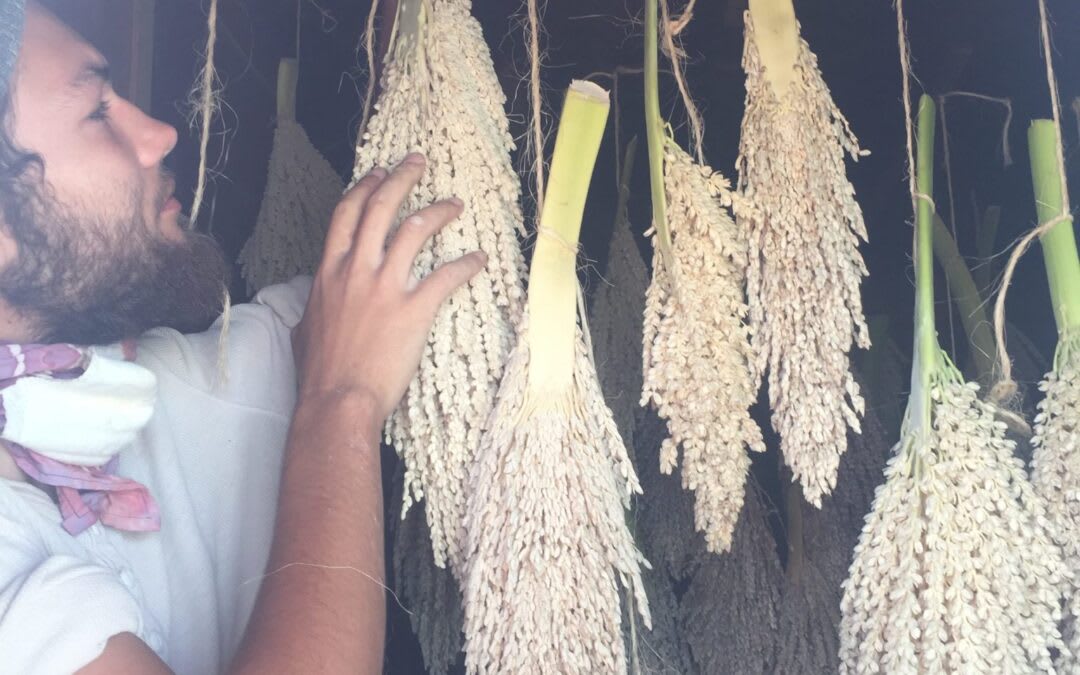Heading into spring, we’ve been getting ready for the date growing season by prepping the trees after their yearly dormancy. Over the past few months we went through and cut off the wicked thorns developed so that we don’t get poked, pricked, or punctured – they’re about 4-5 inches long and can do a lot of damage if you’re not careful! Removing them helps us to work in the trees, and that’s important because there is plenty of work to be done.
Male or female – gender identity of a date palm
Date palms develop as either a male or female of the species. The males produce pollen from massive flowers, which are then used to pollinate the fruit buds on the female trees that will then produce the fruit. Unfortunately, pollination doesn’t happen reliably enough on its own, so we need to help it along by hand. The reason for this? Oddly enough, birds and bees aren’t particularly attracted to date flowers, so we can’t count on them to carry the pollen from the male to the female tree. Left to its own devices, the wind would do part of the job, but it is also not very reliable. If we had to count on wind pollination, that would mean that a full half of our trees would have to be male, reducing the crop by a considerable amount. To maximize our yields and ensure good fruit set, we take matters into our own hands. Labor-intensive, yes. But the benefit to manual pollination is that one male tree can pollinate 40 or even 50 females, allowing us to thin out the male tree population and focus on nurturing the females.
Harvesting the magic potion
The date palm male flowers mature inside of gigantic sheath that often grow to more than four feet in length. Once they begin to split, they are tied together and removed from the tree. During this time, we are out checking the trees every single day. The process of extracting and processing the pollen takes several days. First the flowers are removed from the sheaths and hung upside-down to dry out. Once the flowers are dried we begin to extract the pollen by tapping, shaking, and beating the flowers. Finally, the pollen turns to a fine powder, we sift it through very fine mesh, it sits and dries for one to two more days, and then we transfer it to an air-tight container to store until we are ready to use it. Whew!




Where the magic happens
The female trees produce a sheath that is similar to the males’. When they begin to split, we open them up to reveal the fruit strands inside. We separate each strand, tie them together, and then hand-pollinate them with the dried pollen we collected from the male trees. Each female tree is pollinated up to three times during the process, and will develop lots and lots of fruit buds along each strand.



Starting in April or May, we begin to drop fruit (thin). We go through each strand and take off approximately two-thirds of the fruit, which might seem like a lot, but the tree actually produces the same volume of fruit, either way. Thinning encourages larger fruit overall, so we’ll have fewer, larger dates. It also allows for more even ripening, and better airflow through the strands. What we are left with are voluptuous, plump dates that are significantly better in quality, and with higher sugar concentrations to boot – an absolute must when you are in the business of growing a top-quality product like Naked Dates!
Naked Dates Lifestyle
Whew! That’s a lot of work for such a tiny fruit! But you know, we wouldn’t have it any other way. Here in Wellton, where the date palms grow, we work hard, we play hard, and enjoy the fruits of our labor. It’s a hard-won victory, but if you’ve ever tried our Naked Dates, you’ll know why it’s worth it. Shop online today – or if you’re ever in the Yuma area, drop by the farm, meet us, get your picture taken with Daphne (our Naked Dates VW Bus), and see how we do what we do. You’ll also be able to try some exclusive date products you won’t find anywhere else, like date soap, and date beer. Until then, stay healthy with Naked Dates: try some delicious organic Medjool dates today!

